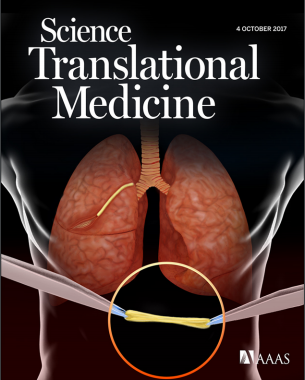Annabi’s Article Selected as Cover for Science Translational Medicine

ChE Assistant Professor Nasim Annabi’s article on “Engineering a highly elastic human protein–based sealant for surgical applications” was featured on the cover of Science Translational Medicine.
A stretchy, sticky alternative to sutures
Repairing tissue ruptures during surgery can be complicated: Suturing requires piercing an already damaged tissue, and sealants such as glues may not match the material properties of the tissue, leading to subsequent leakage or rupture. Annabi et al. capitalized on the elastic properties of the human protein tropoelastin to engineer a photocrosslinkable hydrogel sealant material. The injectable material, MeTro, successfully sealed surgical incisions in blood vessels in rats and in lungs in pigs without evidence of leakage or rupture. Tunable elastic hydrogel sealants offer a promising adhesive, biocompatible, biodegradable material for tissue repair.
Abstract
Surgical sealants have been used for sealing or reconnecting ruptured tissues but often have low adhesion, inappropriate mechanical strength, cytotoxicity concerns, and poor performance in biological environments. To address these challenges, we engineered a biocompatible and highly elastic hydrogel sealant with tunable adhesion properties by photocrosslinking the recombinant human protein tropoelastin. The subcutaneous implantation of the methacryloyl-substituted tropoelastin (MeTro) sealant in rodents demonstrated low toxicity and controlled degradation. All animals survived surgical procedures with adequate blood circulation by using MeTro in an incisional model of artery sealing in rats, and animals showed normal breathing and lung function in a model of surgically induced rat lung leakage. In vivo experiments in a porcine model demonstrated complete sealing of severely leaking lung tissue in the absence of sutures or staples, with no clinical or sonographic signs of pneumothorax during 14 days of follow-up. The engineered MeTro sealant has high potential for clinical applications because of superior adhesion and mechanical properties compared to commercially available sealants, as well as opportunity for further optimization of the degradation rate to fit desired surgical applications on different tissues.